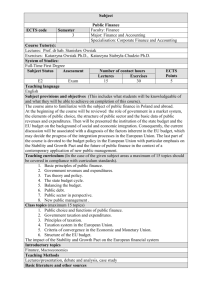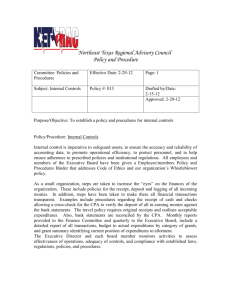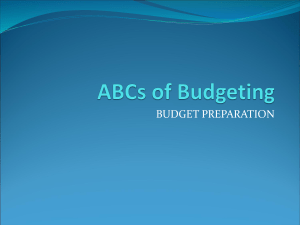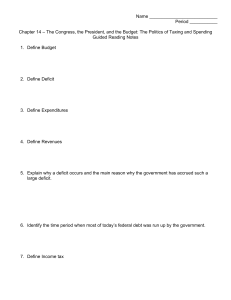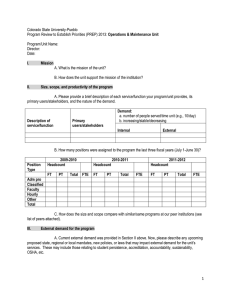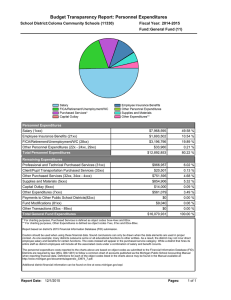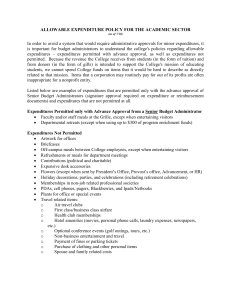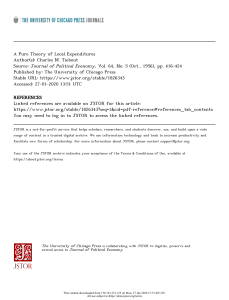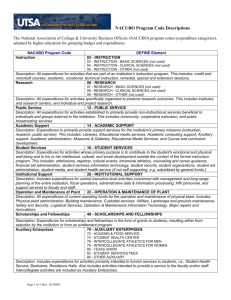Tiebout's Theory of Local Expenditures: A Presentation
advertisement
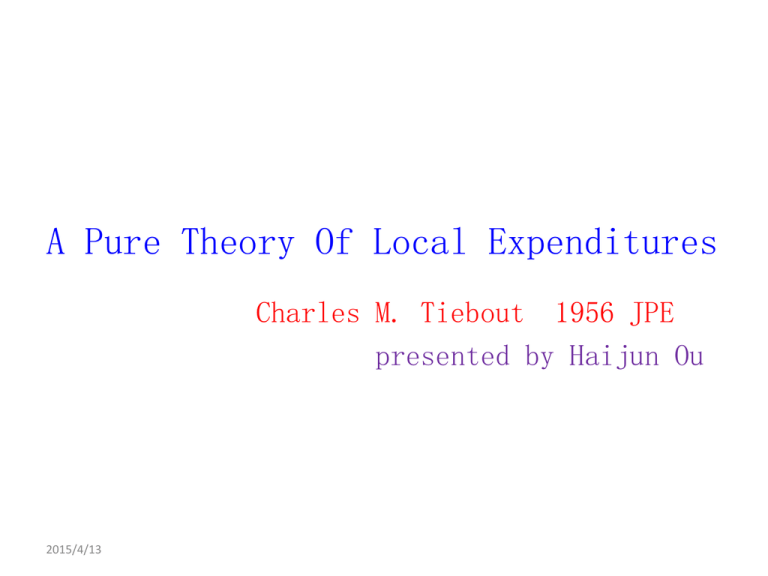
A Pure Theory Of Local Expenditures Charles M. Tiebout 1956 JPE presented by Haijun Ou 2015/4/13 Introduction(1/2) • Musgrave and Samuelson: No market type solution to determine the level of expenditures on public goods. • A rather large portion of national income allocated in a non-optimal way when compared with the private sector. • Government adopts to consumers preferences. The rational consumers will understate……. • The current method ……political mechanism, ability-to-pay principle. • Musgrave and Samuelson assume that expenditures are handled at the central government level. 2015/4/13 Introduction(2/2) • In actual, it is not like this. Local VS central…… • Whether at the local level of government any mechanism operates to insure that expenditures on these public goods approximate the proper level? • Consumer-voters vote by feet to ensure the efficiency of local public goods. • Pure public goods VS local public goods? 2015/4/13 Model(1/4) • Assumptions1: Consumer-voters are fully mobile and will move to community where their preferences are best satisfied. (heterogeneous) • Assumptions2: …have full knowledge of differences among… • Assumptions3: …a large number of communities… differ in provision of local public goods (competition) • Assumptions4:Restrictions due to employment opportunities are not considered. All persons are 2015/4/13 living on dividend income. Model(2/4) • Assumptions5: The public services supplied exhibit no external economies or diseconomies between communities. • Assumptions6: The optimum community size(the lowest average cost) exit…some factor is fixed. (competition) • Assumptions7: Communities below the optimum size seek to attract new residents to lower average costs. Those above optimum size do just the opposite. 2015/4/13 Model(3/4) • Vote by Feet to ensure the efficiency of provision…local public goods. • Moving (or not) reveal the real preferences of consumer-voters on local public goods. 2015/4/13 Model(4/4) • Policy Implications1: municipal integration is justified only if more of any service is forthcoming at the same total cost and without reduction of any other service. • Policy Implications2: policy that promotes mobility and the knowledge of consumersvoters will improve the allocation of government expenditures. 2015/4/13 理论进展(1/3) • Tibout模型将竞争引入政府部门,成为公共经济学的基准模 型 • Tibout模型中的地方政府也是个“黑箱” • Tibout模型直接假定了地方政府能够有效地供给公共物品 • Musgrave(1959)只有税收和支出责任相对应时,分权才能够 改善公共福利 • Oates(1972)研究了最优分权的条件 • 分权将地方政府更直接地置于居民的监督之下 (Dethier,1999) • 分权体制下政府间的“标尺竞争”使得选民可以参考其他地 区评价本地区的政府效率(Baicker,2005) • 分权能够促进公共物品供给 2015/4/13 理论进展(2/3) • Tiebout模型所描述的机制并不能很好地运作,以 至于分权并没有普遍地提升公共物品的供给效率 居民不会因公共服务的差异而完全流动,公共服务的差异 通常不是主要的流动因素(Faguet,2004) 地方政府的运行并不满足效率原则(无效的监督,更容易 被俘获,非效率目标)(Triesman,2000) 在人员素质、技术水平和管理能力上地方政府更差 (Bardhan,2002) 当地方在初始禀赋上差异过大时,落后地区就可能放弃努 力,地方政府竞争可能加剧地区分化(Cai et al., 2005) 2015/4/13 理论进展(3/3) • 第一代财政分权理论:财政分权与公共品提供 • 第二代财政分权理论:财政分权与对地方政府的 激励、经济转型和经济增长 • 激励:Helping hands VS Grabbing hands? • 转型和增长:维护市场,TVEs,基础设施,FDI… • Race to top VS race to bottom? • 市场分割,重复建设,对教育卫生支出的忽视, 环境破坏… 2015/4/13 • 谢谢 2015/4/13
